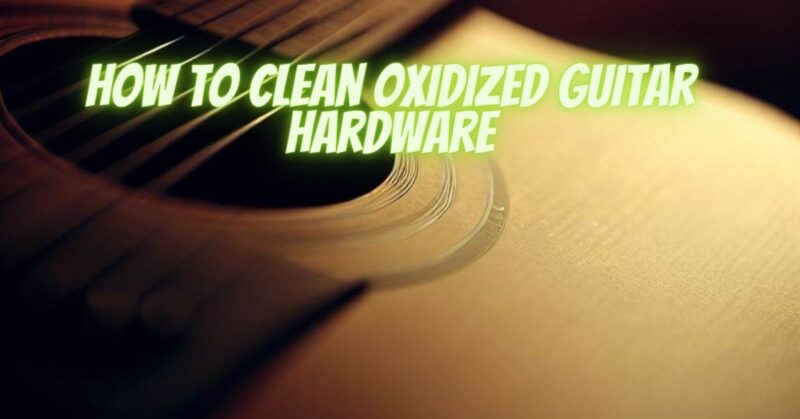Oxidation is a natural process that occurs when metal guitar hardware comes into contact with air and moisture over time. Oxidation can result in the formation of tarnish and corrosion on the metal components of your guitar, affecting its appearance and, in severe cases, its functionality. Regular cleaning and maintenance are essential to keep your guitar hardware in top condition. In this step-by-step guide, we’ll walk you through how to clean oxidized guitar hardware properly to restore its shine and prolong its lifespan.
Tools Needed:
- Soft microfiber cloth
- Mild soap or guitar cleaning solution
- Toothbrush or soft-bristled brush
- Lemon juice or vinegar (optional)
- Steel wool (fine-grade)
- Guitar polish or metal cleaner (optional)
- Cotton swabs (optional)
- Guitar polish cloth or another soft cloth (optional)
Step 1: Remove the Guitar Hardware
If possible, remove the oxidized guitar hardware from your instrument. This step is particularly applicable to smaller components like bridge saddles, screws, knobs, or pickup covers. However, for larger hardware like the bridge or tailpiece, you may need to clean them while still attached to the guitar.
Step 2: Clean with Soap and Water
Start by cleaning the oxidized guitar hardware with a soft microfiber cloth dampened with mild soap and water. Gently wipe the hardware to remove surface dirt and grime. Be cautious not to use excessive force, as you don’t want to scratch the metal surfaces.
Step 3: Use Lemon Juice or Vinegar (Optional)
For stubborn oxidation or tarnish, you can use natural acids like lemon juice or vinegar to help break down the corrosion. Apply a small amount of lemon juice or vinegar to a soft cloth and gently rub the affected areas. The acidic properties will assist in removing tarnish and restoring shine.
Step 4: Scrub with Steel Wool (Fine-Grade)
For more severe oxidation, carefully use fine-grade steel wool to remove stubborn tarnish. Gently scrub the affected areas with the steel wool, moving in the direction of the metal grain to avoid scratching the surface. This step requires a delicate touch to avoid over-scrubbing, especially on plated hardware.
Step 5: Polish (Optional)
If you want to further enhance the shine and protect the metal surfaces, you can apply guitar polish or a specialized metal cleaner. Follow the manufacturer’s instructions for the specific product you choose. Apply a small amount of polish to a soft cloth and buff the hardware to a bright shine.
Step 6: Clean Hard-to-Reach Areas (Optional)
For smaller and intricate hardware, you may use a toothbrush or soft-bristled brush to clean hard-to-reach areas. You can also use cotton swabs dipped in cleaning solution to access tight spaces.
Step 7: Reassemble and Test
Once you’ve cleaned all the oxidized guitar hardware, reassemble the components if necessary. Ensure everything is securely attached to the guitar. Before playing, check that any movable hardware (e.g., tuning pegs, tremolo arm) moves smoothly without resistance.
Step 8: Regular Maintenance
To prevent future oxidation and maintain your guitar hardware’s appearance and performance, establish a regular cleaning routine. Clean the hardware with a soft microfiber cloth after each playing session to remove sweat and fingerprints. Additionally, store your guitar in a controlled environment with proper humidity levels to minimize oxidation.
Cleaning oxidized guitar hardware is a crucial part of guitar maintenance. Regular cleaning will help preserve the appearance and functionality of your guitar’s metal components and prolong their lifespan. By following this step-by-step guide and using the appropriate cleaning tools and products, you can restore the shine and beauty of your guitar hardware, ensuring that your instrument looks and performs at its best for years to come.

